"Coaching The SKU Way!" Official SKU Coaching Resource
May 2015 Issue 59 SKU Quarterly Magazine
Are the variations in kata, as important as they are made out to be?
by Derick Kirkham
Are the variations in kata, as important as they are made out to be?
If any subject has ever existed that is guaranteed to trigger off a conflict of opinion between Karate Kata enthusiasts, then this is it! I refer the situation that exists where a student is faced with a bewildering number of possible technique variations to choose from, that lie in almost every Kata in the Shotokan system. The technique differs dependent on the source of the input. So how does a student know which technique is the correct one? This an age old debate that sparks off much controversy.
Before we review the topic let’s take a look at just one technique to illustrate the point perfectly.
The Example is taken from Kata Kanku
Whether one is performing Kanku, Kwanku, Kushanku, Koshokun, Kosokun, or any other variation of the same kata, then the starting positions will certainly look very similar. However, there are several alternatives as to exactly how the hands should be formed.
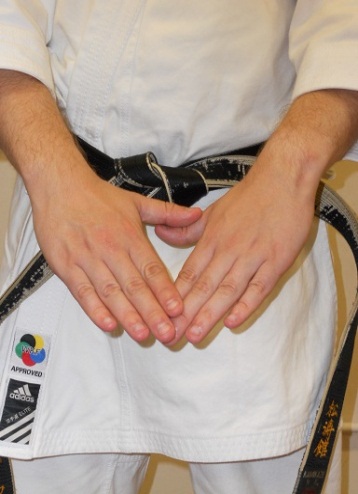
When performing Kanku Dai we at the Shotokan Karate Union form the hands with the left hand under the right, with the index & ring fingers and thumb of the right hand sitting over the index & ring fingers and thumb of the left hand, so that they form a triangular gap between the hands.
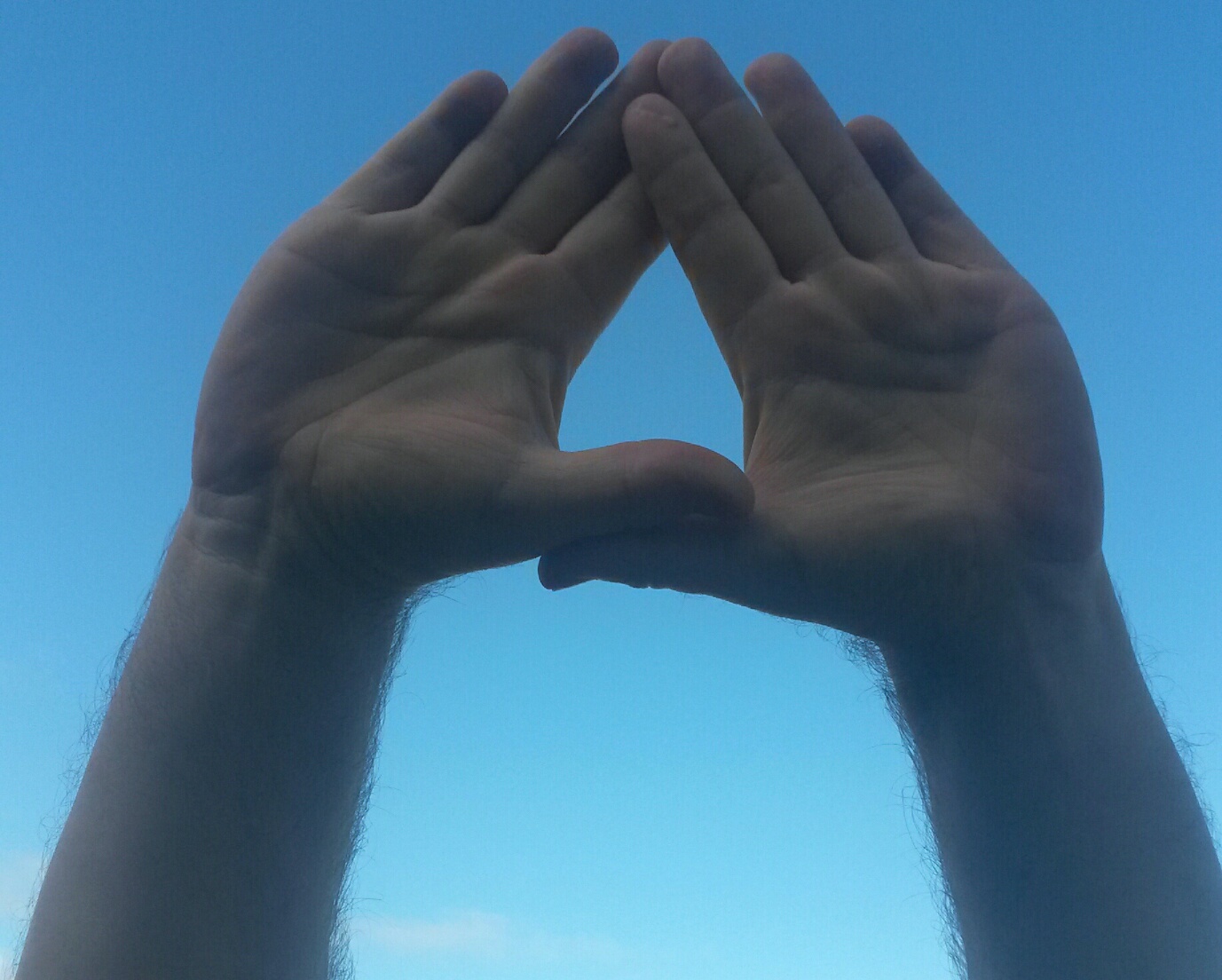
Another Shotokan Ryu variation of Kanku Dai is performed with the left hand under the right, with the index & ring fingers of the right hand sitting over the index & ring fingers of the left hand but the left hand thumb resting on top of the right hand thumb, so that they form the triangular gap between the hands.
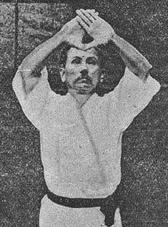
Gichin Funakoshi performing Kushanku who used all fingers and thumb of right hand sitting over the left hand leaving a triangular gap between the hands.
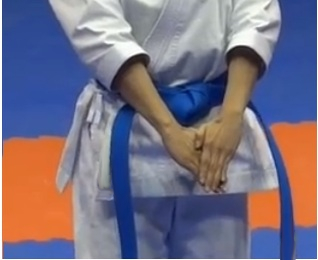
Chatan Yara Kushanku & Koshokun Dai
the complete left hand over the right hand with no triangular gap between the hands.
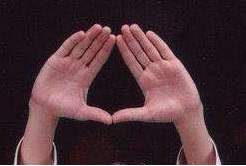
Another variation of Kanku Kata no Kamae is where there is no overlapping of the hands at all but they still form the triangular gap between them.
The Origins of the Debate
This age old debate has caused schisms within ryu's that has led to the formation of new organisations and even new styles of karate being formed in the past. However, it is a debate that will never come to a definitive conclusion, simply because the originators of these Kata have all long since died. And in their lifetimes they never had the advantages of today's modern photographic, video and print technology to document in an undisputable fashion the minute detail of the specifics of their creations. Nor did they have the facility or inclination to spread the secrets of their masterpieces freely to the outside world at large.
If one also takes into consideration the following variables, then it is not too difficult to understand why some senior instructors today vigorously promote and defend their opinions, as being the only true way to perform certain techniques from within the Kata.
Variables For Consideration
1. “The influence of the performer’s style of Karate.”
2. "The Chinese whisper effect" is a variable that happens when a particular aspect of a kata is unintentionally misunderstood by a Karate-ka and then it is misrepresented and inaccurately reproduced while being passed on to their students.
In turn it is then inaccurately passed on to others until it is nothing like the original.
3. "The intent behind practicing and performing the kata"
a) The intent of displaying a dedicated representation of the traditional techniques of the style of the art form.
b) The kata is being treated as a spectacular sporting performance. One that intentionally incorporates exaggerated and super-charged enhancements to increase its spectator appeal.
c) Where the kata is purely being used as an aid memoire and is being practiced as a no frills self-defence fighting rehearsal drill and nothing else.
4. "The influence of the moderniser" is a variable where the performer is promoting the introduction of modifications, by suggesting that they are improvements to the commonly accepted technique.
5. “The purpose of the kata” is a variable where one should consider the motivation for the katas creation.
Also take into consideration the body type and physical attributes of the creator. Then compare them to those of the performer for any obvious mismatches.
Limited Resource & Opportunities In The Early Days Lead to Confusion
When I started to study Karate in 1965, Kata were passed on to us by the Chinese Whispers system.
As many of our club instructors in those early days were Kyu grades themselves.
They eagerly attended weekend kata standardisation courses, then they taught us the same kata on the following Monday.
Our instructors had been informed that, for example, in kata X, move number 4, is done a specific way.
However, too often our instructors were not issued with a valid explanation as to why it was to be performed that particular way.
Nevertheless we were happy in the knowledge that the input we were receiving was accurate as it had come from someone who had been shown by a Japanese instructor.
Albeit we were getting a third hand demonstration of move 4 from kata X, we were quite happy to faithfully follow what we were being shown.
That was all fine, until a few weeks later, after our kyu grade club instructors had attended yet another kata standardisation course.
On their return to the club our instructors were armed with yet another update, which stated that move number 4 from kata X is no longer done the way that we were shown last week.
And again no explanation for the U-turn was given.
These were very confusing and frustrating times for all concerned, especially when a grading examiner would visit the club and they would themselves bring yet another differing opinion of how move 4 from kata X should be performed.
In Search of Clarity
This constant changing of how to perform Kata, was due in no small way to the lack of reliable video and printed reference material at that time.
This left us with no alternative but to seek clarification and instruction which had to come direct from what we thought was at the time to be an infallible source.
I refer to receiving instruction from the Japanese instructors themselves.
We were lucky enough to be getting our input through Mr Kanazawa who was the UK's chief instructor until he was replaced by his assistant Mr Enoeda.
Both of whom had slightly different opinions over various Kata.
If one was prepared to travel then you would be able to train with some of the other assistant Japanese instructors. Such as Mr Tomita, Mr Kato, Mr Asano, Mr Kawasoe.
All of whom are now themselves well respected and equally famous instructors.
This added somewhat to our confusion, as we discovered that not every Japanese instructor taught move 4 from kata X in exactly the same way as their other Japanese colleagues.
And we learnt that they too are susceptible to the "Chinese whisper effect".
If that ball of confusion on its own was not enough to derail ones progress, then consider the other contributory factors that did not help in the demystification of kata.
For example, during the period when Mr Kanazawa was the JKA's representative and chief instructor here in the UK.
He had a period where he taught Enpi kata with a very interesting variation.
For a short while he introduced the use of mawashi geri after the age tsuki & tsukami uke combination as a substitute for the hiza geri.
This variation was published in a kata book by Paul Crompton, which had other interesting anomalies in it, which to this day are points that are vigorously contended by Shotokan Karate kata enthusiasts worldwide.
Variations can even come about as a result of happy accidents, which is thought to be the reason behind why the JKA & the SKIF disagree as to which version of Gojushiho carries the name Sho & which carries the name Dai.
Variations are not usually as obvious as that example. In the main they are quite minor points, such as, "which leg does one move during the block and grab sequence in Bassai Dai". Or "Which arm performs the block over the leg in Jiin.”
Are the variations in kata as important as they are made out to be?
So after taking into consideration the reasons stated above as to why and how variations in kata can come about, then one should ask oneself two questions.
1. Are the variations in kata as important as they are made out to be?
2. Is it important to find out which variation is the true way to perform the kata?
The answer to question 1, is yes.
The variations are important, but only in so much as one should be aware of their existence so as to expand upon ones appreciation of the history of the art form and to improve upon one’s personal technique performance
The answer to question 2 however, is more complex, as there is a widely held belief that the true way to perform the technique, whatever that technique maybe, is not a constant.
It too is a variable, a variable which is dictated by whatever the performer’s motivation is for the practice of and the performance of Kata.
So as long as ones motivation for kata practice remains a constant and that motivation is clearly understood by oneself, then technique variation is of lesser importance, as in the Kanku Dai example, of whether the fingers overlap or not.
But what is of more importance is that one has a thorough understanding of one’s purpose.
One should fully understand and be able to justify to oneself the choice of the technique variation that one uses during kata practice.
This is important so that one has the ability to reproduce a constant and disciplined performance of that technique every time one performs the kata.
When one views a Karate-ka performing kata, it is not which variation of an individual technique that impresses us about their performance.
But it is the precision and the strictly delivered manner in which that technique is presented, which impresses us. Because after all "Good Karate is Good Karate."
Of course kata must be standardised so it is recognisable from the name that it carries, no matter which country in the world you are performing the kata.
In Conclusion
So in conclusion, NO, the variations are NOT as important as they are made out to be.
But what is important is how one performs the chosen technique.
As long as the technique variation that one chooses to perform, is justifiable and appropriate for the purpose of why one is practicing the kata.
And the chosen technique is delivered with all of the form, discipline and the qualities that are regarded to be synonymous with the style of traditional Karate-do that one practices, then they are NOT as important as they are made out to be.
If this approach is adopted as a training rule and is constantly followed, then Kata practice will be of greater overall benefit to ones studies.
Good Luck and Good Practice.
